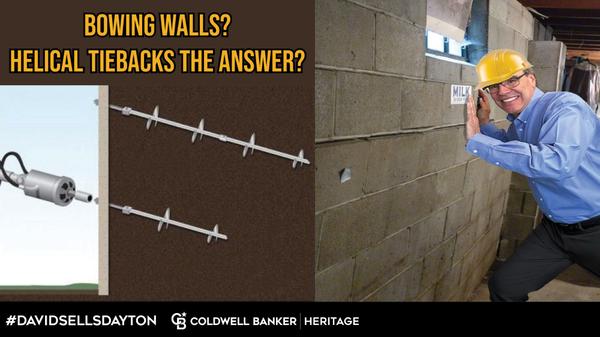
Bowed Foundation Wall - Helical Tiebacks May be the Answer
Are you trying to buy a house and the inspections pointed out a bowing or leaning basement wall? Still want the house? There are options to ensure the wall is stabilized. Helical tiebacks are one answer. The tiebacks are a simple two piece system consisting of the tieback and plate. The tieback is essentially a giant screw about 10 feet long. A hole is drilled through the bowed wall and the tieback is inserted in the hole and ‘drilled’ into the earth behind the wall. The tieback is run in until just a few inches is protruding from the wall. Next, a steel plate with a hole is placed over the protruding end of the tieback and a nut is then screwed on. This nut is tightened to a certain spec that ensures tension on the wall. There you have it, the wall is now reinforced by the tension of the tieback working to keep the wall stabilized in place. How much do helical tiebacks cost, around 2000.00 each. Your application may require several. Keep in mind these don’t always straighten the wall. They stabilize it to stop further movement. They can work well on retaining walls too. I see these from time to time as I help people buy and sell real estate in the Dayton, Ohio area. Wall anchors are another option to stabilize. I’ll cover that in another post.

Slab Jacking: The Quickest Way to Correct Uneven Concrete
Do you have a sidewalk, patio or driveway that has settled or tilted and no longer even? Before you have it torn out and repoured, consider a solution that is less than half the cost. Slabjacking or lifting the concrete panel back into its original position is the quickest, cheapest, least messy way to handle it. The fix: One or more holes are drilled into the concrete. A grout-like material is pumped in the hole forcing the pad to ‘float’. Once the original position is reached the hole/holes are filled with a concrete mix and the grout will dry and it’s done! It’s that quick and simple. I’ve had many home sales ‘saved’ with this method. Feel free to reach out if you need further explanation or a referral for a contractor of this kind of work. It’s important to know why your patio settled? I commonly see this when showing and selling homes in the Dayton, Ohio area. It’s typically one of two things: The soil underneath was not properly compacted during construction. It’s really difficult to get the excavated soil around a construction site packed back down to the density it was before it was disturbed. Over multiple rains and freeze/thaw cycles it compacts tight again and shrinks taking the concrete slab with it. This kind of settling might start to show up at about the 5 yr mark after construction. Improper drainage or ponding around a concrete pad will compact the soil as well.

NAR Settlement - Home Buyer Change Explained
The National Association of Realtors Settlement has created a change on the buyer side of things. This change is nationwide, not brokerage or state specific. Now, all buyers who would like to tour a home with their broker must sign a buyer representation agreement with their agent PRIOR to being able to see the property. In the past, a buyer could contact a Realtor and request a showing without signing this. These buyer agreements are not new. A lot of agents have used them for years. Now, however, they are mandatory with everyone. Going forward, the new license law requirement is that a buyer agreement must be signed PRIOR to any showing taking place. The agreement clearly outlines the compensation paid to your agent. Typically, the seller will offer payment to the buyer’s agent just like in the past so that it is easier for the buyer to buy. However, if a seller is only offering partial or no compensation, the buyer will be responsible for the remainder. The changes on the buyer and seller side of things may leave you with questions on how they will work in practice. I work everyday in the Dayton housing market and would be happy to discuss how it all works.
Categories
Recent Posts










